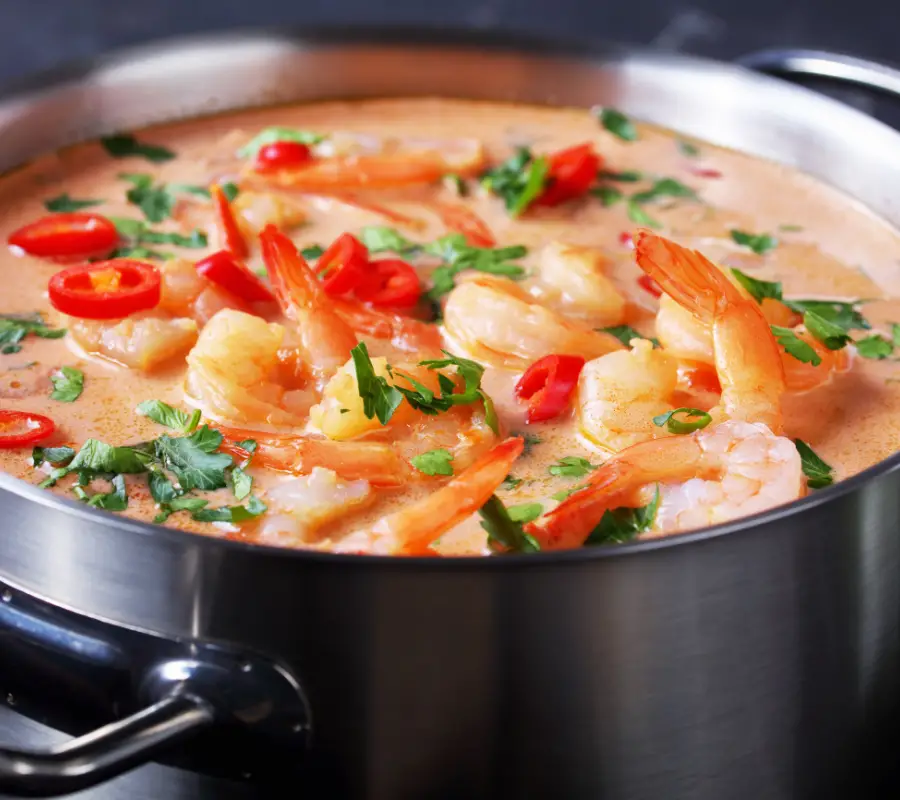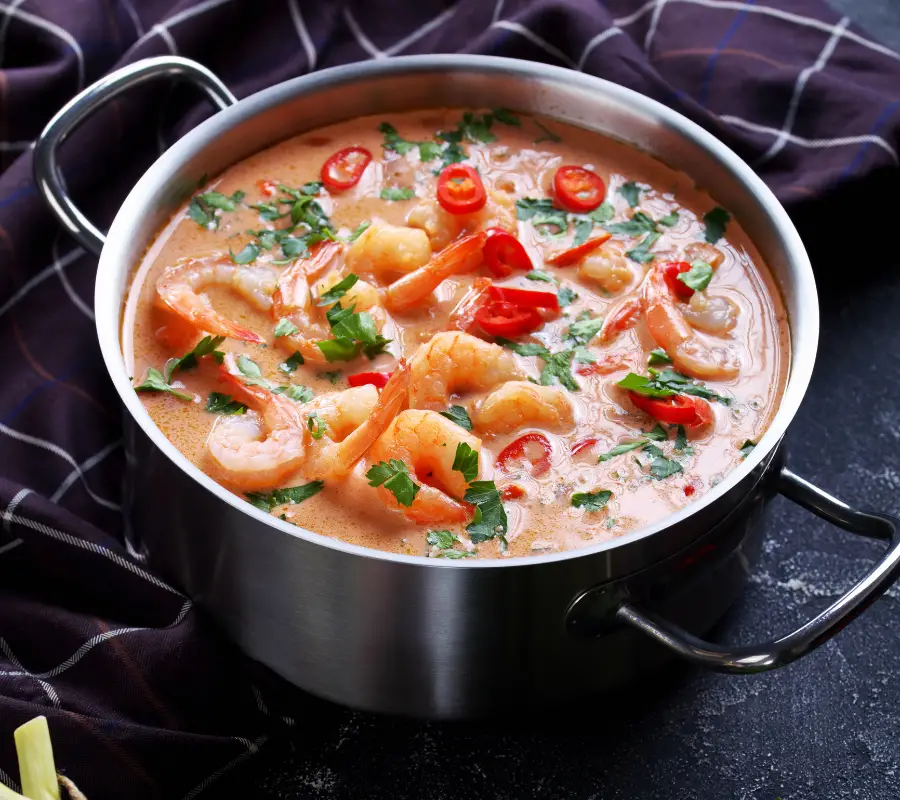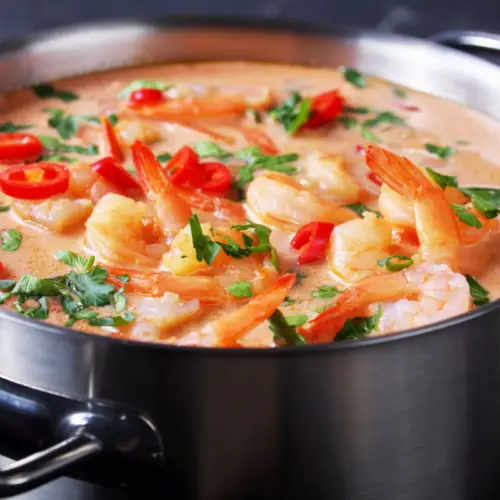Easy Thai Tom Yum Noodle Soup: Authentic Thai Flavours
Immersing oneself in the culinary delights of Thai cuisine brings one to the aromatic and flavourful world of Tom Yum Noodle Soup. This soup is a symphony of taste, seamlessly blending the zest of lime, the heat of chillies, and the depth of fish sauce with succulent noodles and a selection of fresh ingredients. It is a dish that offers a truly sensational eating experience, promising to satiate with each spoonful.
In the comfort of one’s kitchen, Tom Yum Rice Noodle Soup can be crafted to suit individual preferences, whether it be the heat of the spices or the variety of ingredients included. For those who seek to expand their soup repertoire, options like a vibrant purple cabbage soup offer a different yet equally enticing homemade treat, boasting not just visual appeal but a richness in flavour.

Key Tips
- Tom Yum Noodle Soup offers a unique blend of tangy, spicy flavours with fresh, vibrant ingredients.
- The recipe is versatile and can be adjusted to personal taste, making it perfect for home cooking.
- Additional recipes, like purple cabbage soup, provide further explorations into rich, comforting flavours.
Ingredients
- 700 ml chicken stock (unsalted)
- 950 ml water
- 3 stalks of lemongrass (white/yellow part only, bruised and then cut into 2 to 3 inch chunks)
- 1 Galangal (Cut into thin slices)
- 12 Kaffir lime leaves (Roughly chopped)
- 3 Green/red chilies (finely chopped)
- 4 Cloves of garlic (Finely chopped or grated)
- 145 g Fresh shimeji / beech mushrooms (Or your favourite mushroom)
- 1 Tomato (cut into wedges)
- 3 Shallots (Cut into wedges)
- 3 tsp Tom Yum Paste
- 4 tbsp Fish Sauce
- 500 g Raw prawns/shrimps – peeled. Leave tail on or off
- 2 tbsp Thai Chilli Paste
- 250 ml Coconut Milk
- 1 tsp Salt
- 1 tsp Sugar
- 230g Rice Noodles
- 6 tbsp Lime Juice
- Lime wedges (for serving)
- Fresh Coriander/Cilantro (for garnish)
How To Make Creamy Tom Yum Noodle Soup
- Stock Preparation: Heat stock and water in a pot and bring to a simmer. Add the bruised lemongrass, galangal, kaffir lime leaves, and chillies. Simmer gently for 12 – 14 minutes to let the flavours infuse. Then sieve out some or all of the lemongrass, galangal, and kaffir lime leaves as they are inedible. Add the coconut milk and cook for a further 2 minutes.
- Mushrooms and Prawns: Incorporate straw mushrooms and prawns into the simmering stock. Cook until the prawns are pink and cooked through, approximately 5 minutes. Add the garlic, tom yum paste and chilli paste.
- Flavouring: Stir in fish sauce, sugar, salt and lime juice. Adjust these ingredients to taste; the soup should be a balance of spicy, salty, sweet, and sour. Add the tomato wedges and shallots.
- Noodles: In a separate bowl, soak the rice noodles in boiling water until tender. Drain and divide among serving bowls.
- Final Touches: Ladle the hot soup over prepared noodles. Garnish each bowl with fresh coriander. For additional heat, a spoonful of chilli paste can be swirled into individual servings.
Understanding Tom Yum
Tom Yum is a renowned Thai soup noted for its distinct hot and sour flavours. There are different variations of this comforting dish, each featuring a specific protein:
- Tom Yum Goong: Includes shrimp or prawns.
- Tom Yum Pla: Contains fish.
- Tom Yum Gai: Made with chicken.
- Tom Kha Gai: Chicken, enriched with galangal and creamy coconut milk.
The soup can be found in two primary forms:
- Clear Tom Yum (Tom Yum Nam Sai): Without milk, offering a translucent appearance.
- Creamy Tom Yum (Tom Yum Nam Khon): Uses coconut milk or evaporated milk, adding to its richness.
Whether indulging in a bowl of noodle-laden Tom Yum or savouring its original version, this Thai soup is both versatile and widely cherished.

Notes on Ingredients
Thai Roasted Chilli Sauce (Nam Prik Pao)
This essential component of Tom Yum provides a unique blend of umami, sweetness, and spiciness, thanks to a mix of roasted chillies, shallots, garlic, and more. Authentic versions are Thai-made and can be stored chilled once opened.
Essential Tom Yum Aromatics
For an authentic flavour, look for premade Tom Yum pastes that originate from Thailand. Keep paste refrigerated post-opening, or freeze in cube portions for long-term use.
Flavour-Enhancing Fish Sauce
A staple in East Asian cooking, fish sauce adds a rich umami taste. Store in the fridge for extended freshness, and opt for ones with minimal ingredients, like the Squid Brand from Thailand.
Fragrant Lime Leaves
Fresh leaves impart more flavour than dried and can be frozen in small packets, eliminating air, for future use.
Refreshing Lemongrass
This tropical grass stalk infuses a distinct aroma into dishes. It’s often removed after cooking but can be left in for traditional serving. Freeze any unused portions for later use.
Distinctive Galangal Root
A relative of ginger, galangal cannot be substituted with its cousin and should be looked for fresh or frozen. Leftovers can be sliced and frozen in single-use packets.
Versatile Tomatoes
Various red tomatoes are suitable for Tom Yum, with cherry tomatoes being a convenient alternative when halved.
Noodles
For types of noodles and their use in Tom Yum, please refer to the FAQ section.
Rich Chicken Broth
Adds complexity to the soup. Use unsalted if available, or adjust seasoning as necessary when using salted or bouillon substitutes.
Prawns/Shrimps
Large or medium-sized, ideally thawed from frozen, can be used interchangeably, although small sizes are less preferred due to shrinkage during cooking.
Substitute for Shallots or Onions
A single onion can replace three medium shallots, cut into wedges for the soup.
Mushrooms for Texture
Fresh mushrooms like Shimeji, oyster, or enoki add depth, while straw mushrooms are traditionally used in Thailand. Fresh is preferable to canned for flavour and texture.
Creamy Base Options
Evaporated milk or coconut milk can be used for a creamier Tom Yum, with the latter providing an extra layer of taste, especially suitable for those avoiding lactose. Use canned coconut milk, not the diluted variety.
Common FAQ’s About Tom Yum Noodle Soup Preparation
What noodles are suitable for Tom Yum Noodle Soup?
- Rice stick noodles are typically selected for their subtle taste that doesn’t alter the soup’s flavour.
- However, you’re free to use any kind of noodles you enjoy; cooking them as per the packet’s directions.
- Though instant ramen noodles can be a quick alternative, avoid using their accompanying seasoning sachets.
Is it possible to prepare Tom Yum Noodle Soup with chicken?
- Certainly, using boneless, skinless chicken breast is a viable option.
- Slice the chicken thinly, especially when it’s partially thawed, to speed up the cooking.
- For cooked chicken leftovers, add them toward the end to prevent them from becoming too dry.
Can evaporated or condensed milk be used in place of coconut milk?
- Evaporated milk may be used for a creamier version of the soup.
- Condensed milk, which is sweetened, is unsuitable as it will overly sweeten the soup.
Alternatives for fresh kaffir lime leaves?
- Seek out frozen kaffir lime leaves if fresh ones are unavailable.
- Lime zest can be an alternative, using roughly 1 teaspoon to compensate. In this case, tom yum paste is essential to retain the soup’s authentic taste.
What if fresh lemongrass isn’t available?
- Substitute with frozen lemongrass, ensuring you use sizable pieces, at least two inches long.
- Avoid finely chopped frozen lemongrass or lemongrass paste as they won’t provide the desired effect in the recipe.
Guidance for Culinary Triumphs
- Integrating Lime Juice After Cooking: One should incorporate lime juice into the dish a couple of minutes post removal from heat. This tactic preserves its vibrant zest and averts the possibility of bitterness that may ensue if added during the boiling phase.
- Timing Noodle Addition: To prevent sogginess, it’s prudent to add noodles to the dish right before consumption. This approach not only keeps the noodles firm but also allows personalisation with the soup-to-noodles ratio and facilitates keeping any surplus of the dish for future enjoyment.
- Choosing the Right Broth: When crafting a homemade broth, selecting an unsalted chicken base is advisable. For broths containing salt, revise the seasoning elements accordingly, such as reducing the amount of fish sauce. Refrain from substituting with beef stock as it can significantly alter the expected savoury note.
- Personalising Flavours: Adjust the final taste profile to your preferences. Beyond the base recipe, one might temper the tanginess with a bit of sugar, elevate heat levels with additional Thai chilies, or amplify the tartness with extra lime juice, creating a bespoke balance tailored to individual palates.
- Harmonising Salinity and Spices: It is important to taste and tweak the levels of salt and spices towards the end, ensuring the final product is neither too spicy nor unduly salty. This is essential for maintaining a holistic and healthy flavour profile that caters to varied tastes—especially important for those seeking a vegan or clear broth experience.
Adjusting Recipe Proportions for Spiciness
When multiplying a recipe, caution is advised with piquant components such as chilli. The perceived heat can intensify more than the actual increase in quantity. It’s prudent to add only 50% more of the fiery elements for each extra serving intended. For instance, if adding Thai or Bird’s eye chilli, this method ensures a balanced flavour profile. Should the dish require more heat, the quantity can be incrementally augmented. This approach allows for taste adjustment without overwhelming the dish’s overall palate.
- Initial serving: 100% of the piquant ingredient
- Additional serving: Add only 50% more of the ingredient
- Taste and adjust if needed for extra heat
Preparing in Advance
Soup Preparation:
- Complete soup (minus noodles) is suitable for refrigerating or freezing.
- Avoid pre-cooking shrimp.
Reheating Instructions:
- Heat soup to a steady boil on medium-high heat.
- Add raw shrimp, which have been thawed to room temperature.
- Cook shrimp for 1-2 minutes until they are no longer translucent.
Flavour Adjustments:
- Enhance sourness with additional lime juice.
- Increase saltiness with extra fish sauce.
- Boost heat with more Thai chili paste or chopped Thai chilies.
Serving Suggestion:
- Prepare noodles freshly just before serving to ensure optimal texture.
Freezing Tips:
- Soup may be frozen without shrimp and noodles for several days.
- Refer to storage recommendations for freezing guidelines.
Storing Methods
Efficient preservation of soup involves cooling it to ambient temperature before placing it in an impermeable container. Keep soups WITHOUT added seafood or noodles refrigerated for up to 48 hours or frozen for a maximum of 90 days.
- Refrigeration: Store separated components – soup and noodles in distinct airtight containers.
- Freezing:
- Utilise freezer bags for soup, leaving space at the top.
- Arrange bags flat on baking sheets in the freezer.
- Reserve flavour by freezing without shrimp or noodles.
- Reheat soup while cooking shrimp and prepare noodles afresh.
- Ingredients Storage:
- Preserve uncommon items like kaffir lime leaves, lemongrass, and galangal by freezing.
Warming Up Soup
When warming soup that has been refrigerated or stored at room temperature, it’s preferable to use a stovetop. Microwaves often heat soup unevenly which can be problematic, particularly for larger amounts.
For those opting to use a microwave, the following guidelines will ensure better results:
- Utilise a container suitable for microwave use.
- Initiate warming by setting the microwave timer to 60 seconds.
- Proceed with additional 30-second intervals as necessary to achieve desired temperature.
- Periodically halt the microwave to stir the soup, aiding uniform heat distribution and averting mess.
Regarding frozen soup, a thorough defrost in the fridge yields the best results, taking from one to two days, influenced by container dimensions and fridge temperature.
Variations
- Noodle Choice: Opt for any preferred noodles.
- Rice Alternative: Incorporate sticky or steamed rice for a Tom Yum Rice Soup variation.
- Protein Options: Substitute shrimp with thin slices of boneless chicken.
- Flavour Adjustments:
- For tanginess, increase lime juice.
- Sweetness can be enhanced with sugar.
- More coconut or evaporated milk will yield a creamier soup.
- Augment spiciness with extra chopped chilies or Thai chili paste.
Creative Presentation of Starters
- Offer noodle soup adorned with fresh coriander
- Include wedges of lime and finely minced Thai chillies for additional garnishing options
- Perfect for sharing in a convivial Thai restaurant setting

Easy Thai Tom Yum Noodle Soup : Authentic Thai Flavours
Equipment
Ingredients
- 700 ml chicken stock (unsalted)
- 950 ml water
- 3 stalks of lemongrass (white/yellow part only, bruised and then cut into 2 to 3 inch chunks)
- 1 Galangal (Cut into thin slices)
- 12 Kaffir lime leaves (Roughly chopped)
- 3 Green/red chilies (finely chopped)
- 4 Cloves of garlic (Finely chopped or grated)
- 145 g Fresh shimeji / beech mushrooms (Or your favourite mushroom)
- 1 Tomato (cut into wedges)
- 3 Shallots (Cut into wedges)
- 3 tsp Tom Yum Paste
- 4 tbsp Fish Sauce
- 500 g Raw prawns/shrimps – peeled
- 2 tbsp Thai Chilli Paste
- 250 ml Coconut Milk
- 1 tsp Salt
- 1 tsp Sugar
- 230g Rice Noodles
- 6 tbsp Lime Juice
- Lime wedges (for serving)
- Fresh Coriander/Cilantro (for garnish)
Instructions
- Stock Preparation: Heat stock and water in a pot and bring to a simmer. Add the bruised lemongrass, galangal, kaffir lime leaves, and chillies. Simmer gently for 12 – 14 minutes to let the flavours infuse. Then sieve out some or all of the lemongrass, galangal, and kaffir lime leaves as they are inedible. Add the coconut milk and cook for a further 2 minutes.700 ml chicken stock, 950 ml water, 3 stalks of lemongrass, 1 Galangal, 12 Kaffir lime leaves, 3 Green/red chilies, 250 ml Coconut Milk
- Mushrooms and Prawns: Incorporate straw mushrooms and prawns into the simmering stock. Cook until the prawns are pink and cooked through, approximately 5 minutes. Add the garlic, tom yum paste and chilli paste.4 Cloves of garlic, 145 g Fresh shimeji / beech mushrooms, 3 tsp Tom Yum Paste, 500 g Raw prawns/shrimps – peeled, 2 tbsp Thai Chilli Paste
- Flavouring: Stir in fish sauce, sugar, salt and lime juice. Adjust these ingredients to taste; the soup should be a balance of spicy, salty, sweet, and sour. Add the tomato wedges and shallots1 Tomato, 3 Shallots, 4 tbsp Fish Sauce, 1 tsp Sugar, 6 tbsp Lime Juice, 1 tsp Salt
- Noodles: In a separate bowl, soak the rice noodles in boiling water until tender. Drain and divide among serving bowls.230g Rice Noodles
- Final Touches: Ladle the hot soup over prepared noodles. Garnish each bowl with fresh coriander. For additional heat, a spoonful of chilli paste can be swirled into individual servings.Fresh Coriander/Cilantro, Lime wedges
Nutrition
Other Asked Questions
How Is Sukhothai-Style Tom Yum Noodle Soup Prepared?
To craft Sukhothai-style Tom Yum Noodle Soup, begin with boiling broth and add aromatics such as lemongrass, galangal, and kaffir lime leaves. Then, insert sliced meats or tofu, followed by fish sauce, chili, and palm sugar for a balanced flavour. The noodles are served separately, then combined with the prepared broth.
What Constituents Are Found in Tom Yum Noodle Soup?
- Broth: chicken or vegetable stock
- Herbs & Spices: lemongrass, galangal, kaffir lime leaves, chilies
- Proteins: shrimp, chicken, or tofu
- Vegetables: mushrooms, tomatoes
- Souring Agent: lime juice
- Seasonings: fish sauce and palm sugar
- Noodles: typically rice noodles
Is There a Vegetarian Variation of Tom Yum Noodle Soup?
Yes, Tom Yum Noodle Soup can be adapted for vegetarians using the following substitutes:
- Broth: Vegetable stock instead of chicken or shrimp stock
- Proteins: Tofu instead of meat or seafood
- Seasonings: Soy sauce or tamari instead of fish sauce
Caloric Content of a Standard Serving of Creamy Tom Yum Noodle Soup?
| Serving Size | Calories |
|---|---|
| 1 Bowl | Approx. 442 calories |
What Gives Tom Yum Soup Its Signature Flavour?
The distinctive taste of Tom Yum Soup comes from a blend of sour and spicy flavours, primarily due to the use of:
- Sour: Lime juice and tamarind paste
- Spicy: Fresh Thai chilies
- Aromatic: Lemongrass, galangal, and kaffir lime leaves
Locating Tom Yum Noodle Soup Nearby?
To find Tom Yum Noodle Soup locally, one can:
- Visit Thai restaurants or eateries specializing in Southeast Asian cuisine.
- Check apps and websites that consolidate local restaurant menus and offerings.
- Search for specialised food markets that might offer fresh or packaged Tom Yum Noodle Soup ingredients.